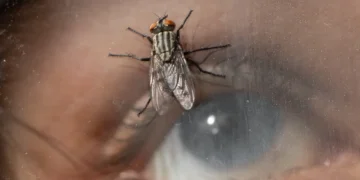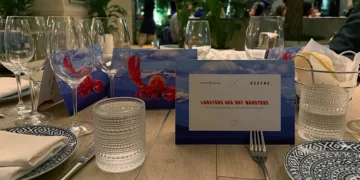
Rirkrit Tiravanija exhibition, “DAS GLÜCK IST NICHT IMMER LUSTIG” (Happiness is not always fun), at Gropius Bau in Berlin is a retrospect of his work from the late 1980s to 2024. This ambitious show explores the artist’s long-standing connection to Germany, which has influenced both his artistic practice and personal life. Through his use of a wide range of media, from paper works and sculptures to Super 8 films, the exhibition reflects on Germany’s cultural and political landscape while addressing the global movement of people and ideas. Tiravanija’s choice to incorporate both older works and new participatory installations is also a reflection on his ongoing evolution as an artist.

One of the core aspects of Tiravanija’s practice, and a prominent feature of the exhibition, is the artist’s emphasis on participatory experiences. He famously pushes the boundaries of traditional exhibition spaces, creating environments where viewers are invited to actively engage with the art. The installation “untitled غداً هو السؤال) 2024 ) (tomorrow is the question)” exemplifies this. Consisting of eight ping-pong tables, it transforms the Gropius Bau atrium into a social space, inviting visitors to play and interact with strangers and friends. This piece, like many of his works, remove the barrier between art and audience, turning the exhibition into a living, ever-changing experience.
EXHIBITIONS
Tiravanija’s ability to connect political commentary with everyday interactions is particularly present in this show. Having lived part-time in Germany since the early 1990s, he has continually engaged with the country’s socio-political climate in his art. The exhibition’s title, borrowed from Rainer Werner Fassbinder’s film “Ali: Fear Eats the Soul,” immediately establishes a dialogue with Germany’s post-war history, exploring themes of migration, cultural alienation, and belonging.
The exhibition also showcases Tiravanija’s interest in ephemeral art, with regular activations of his most important participatory works. These activations, whether in the form of communal meals or performances, bring the artworks to life in real-time, further emphasizing the transient, relational nature of his practice. Such works challenge traditional notions of art as a static object, instead positioning it as a process or event. The inclusion of daily public performances on the spiral-shaped stage, “untitled 2024 (demo station no. 8),” adds a layer of unpredictability to the exhibition.

Beyond participation, the exhibition offers a comprehensive look at Tiravanija’s creative output across various mediums. Rarely seen Super 8 films, photographs, and sculptures offer insights into his development as an artist. By displaying these works alongside his newer participatory pieces, the exhibition highlights the evolution of his approach.
Curated by Jenny Schlenzka, Yasmil Raymond, and Christopher Wierling, the Rirkrit Tiravanija exhibition at Gropius Bau in Berlin provides a platform for Tiravanija to experiment with institutional boundaries. Gropius Bau, with its history as a site of artistic production, becomes an integral part of the experience. The exhibition extends beyond the gallery walls, transforming the atrium into a public space for interaction and contemplation.




















very cool 😍😍